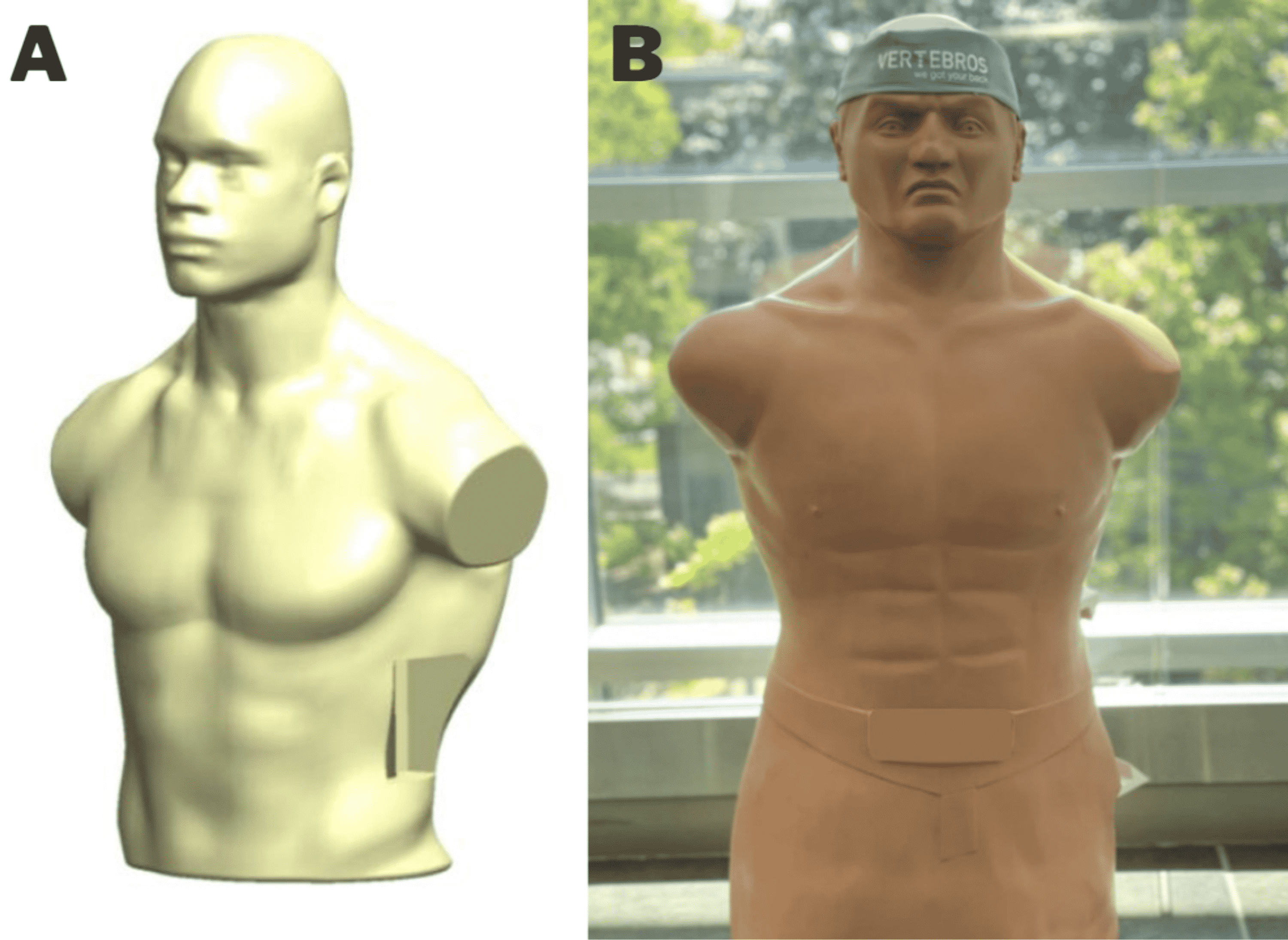A group of researchers from the Mayo Clinic, the Georgia Institute of Technology, and the Medical University of South Carolina have 3D printed a low-cost proof-of-concept spinal surgical simulator.
The aim of the study is to raise awareness of the lack of current surgical training alternatives to traditional methods that can be inconvenient, inaccessible, and incompatible with intraoperative neuromonitoring (IONM) systems.
Offering a low-cost alternative, the team created the lateral access training model (LATM), which features 3D printed lumbar vertebrae verified for anatomical accuracy.
 The CAD rendering (left) and the proof-of-concept LATM surgical simulator (right). Image via Cureus.
The CAD rendering (left) and the proof-of-concept LATM surgical simulator (right). Image via Cureus.
Improving spinal surgery with 3D printing
Additive manufacturing has found its place in the medical sector, particularly in regard to improving surgical training and outcomes. Spinal surgery is no different, with the technology promising to enhance the success rates of spinal surgeries and treatments.
As far as treatment goes, researchers at the University of Minnesota developed a prototype for a 3D printed scaffold with living cells that could potentially restore some function to patients with spinal cord injuries, while scientists from the University of California San Diego successfully 3D printed a two-millimeter spinal cord implant to repair spinal cord injuries in rats. Most recently, regenerative medicine firm Matricelf successfully tested a first-of-its-kind 3D printed spinal cord tissue implant that enabled paralyzed mice to walk again.
Regarding improving surgical training and outcomes, orthopedic implant firm 4WEB Medical’s stand-alone 3D printed Anterior Spin Truss System is providing surgeons with greater confidence during spinal procedures, and 3D printed orthopedic device developer Orthofix Medical has developed its FORZA Ti PLIF Spacer System designed for use in Posterior Lumbar Interbody Fusion surgeries.

The 3D printed LATM
Minimally invasive lateral lumbar interbody fusion (LLIF) is a relatively recent development in spinal surgery, providing minimally invasive access for indirect nerve decompression and the correction of lumbar degenerative deformities while avoiding the challenges and risks of traditional approaches. However, the technique requires a specialized team and advanced equipment, and current training tends to be limited to classic educational models and cadaver labs, which can be inconvenient, inaccessible, and expensive.
To highlight the lack of current training alternatives, the team’s study aimed to create a fully synthetic and low-cost proof-of-concept lateral lumbar surgical simulator. Before fabricating the model, the team interviewed a selection of neurosurgeons, engineers, nurses, and industry partners with a thorough understanding of the LLIF procedure to provide critical input on the visual, tactile, and auditory feedback required for the model.
Manufacturing on Demand
The LATM is made up of a torso casing, spine module, and IONM feature, and features operable ABS 3D printed lumbar vertebrae. The vertebrae are verified for anatomical accuracy and compatibility with fluoroscopy, a medical procedure that makes a real-time video of movement inside a part of the body. The advantage of using 3D printed ABS is that it performs well with spinal instrumentation, the researchers said.
Additionally, the LATM secures the individual 3D printed vertebrae and pelvis with a flexible polymer tube housed within the spinal canal. The thecal sac and nervous tissue sit within the vertebral canal, meaning that having a support structure in this area does not interfere with the operability of the model as the spinal canal should never be violated during LLIF.
The model works in tandem with a novel neuromonitoring simulation algorithm which was developed to train junior surgeons on neurological complications. According to the team, 3D printing surgical simulators could potentially reduce the learning curve for LLIF surgeries, enable presurgical practice, and ultimately improve patient outcomes.
The experts interviewed at the beginning of the design process provided unanimous positive feedback regarding the LATM, marking the simulator as a first step towards providing reliable and inexpensive basic lateral lumbar spine training. Although it lacks some anatomical features, the simulator offers novel training opportunities for lateral lumbar surgical approaches while also laying the foundation upon which future models can be built.
The team said future iterations could impact the future of individualized medicine by providing inexpensive, realistic, and customizable models, and subsequently lead to increased patient safety and improved surgical outcomes.
Further information on the study can be found in the paper titled: published in the Cureus journal. The study is co-authored by M. Pullen, F. Valero-Moreno, S. Rajendran, V. Shah, B. Bruneau, J. Martinez, A. Ramos-Fresnedo, A. Quinones-Hinojosa, and W. Fox.
You might also like:
New study assesses effectiveness of 3D printed titanium implants on bone growth: A total of 16 patients were observed during the study, each undergoing reconstructive surgery for various maxillofacial defects. The patients were fitted with customized titanium implants and received long term follow-ups over the course of numerous months.
* This article is reprinted from 3D Printing Industry. If you are involved in infringement, please contact us to delete it.
Author: Hayley Everett

Leave A Comment